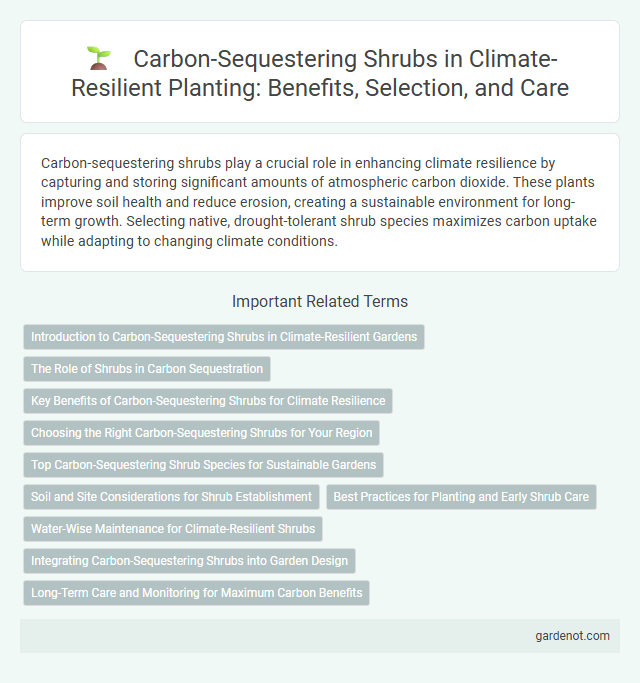Carbon-sequestering shrubs play a crucial role in enhancing climate resilience by capturing and storing significant amounts of atmospheric carbon dioxide. These plants improve soil health and reduce erosion, creating a sustainable environment for long-term growth. Selecting native, drought-tolerant shrub species maximizes carbon uptake while adapting to changing climate conditions.
Introduction to Carbon-Sequestering Shrubs in Climate-Resilient Gardens
Carbon-sequestering shrubs play a vital role in climate-resilient gardens by absorbing and storing atmospheric carbon dioxide, reducing overall greenhouse gas levels. Species such as sea buckthorn (Hippophae rhamnoides) and dogwood (Cornus spp.) efficiently capture carbon through rapid biomass growth and extensive root systems. Integrating these shrubs into landscaping enhances soil health, conserves water, and supports biodiversity while mitigating climate change impacts.
The Role of Shrubs in Carbon Sequestration
Carbon-sequestering shrubs play a crucial role in climate-resilient planting by capturing atmospheric carbon dioxide and storing it in their biomass and root systems. Species such as evergreen shrubs and deep-rooted varieties enhance soil organic carbon levels, improving soil health and reducing greenhouse gas concentrations. Integrating these shrubs into reforestation and land restoration projects significantly boosts carbon sequestration capacity while supporting biodiversity and ecosystem resilience.
Key Benefits of Carbon-Sequestering Shrubs for Climate Resilience
Carbon-sequestering shrubs enhance climate resilience by capturing atmospheric carbon dioxide and storing it in biomass and soil, reducing greenhouse gas concentrations. These shrubs improve soil health, increase biodiversity, and provide habitat for pollinators, supporting ecosystem stability under changing climate conditions. Their deep root systems also prevent soil erosion and increase water retention, promoting landscape resilience during extreme weather events.
Choosing the Right Carbon-Sequestering Shrubs for Your Region
Selecting carbon-sequestering shrubs tailored to your region's climate and soil conditions maximizes their carbon capture efficiency and resilience. Native species like Ceanothus in Mediterranean climates or Itea in temperate zones offer optimal growth and carbon storage. Incorporating drought-tolerant and deep-rooted shrubs enhances soil carbon sequestration while supporting local biodiversity and ecosystem health.
Top Carbon-Sequestering Shrub Species for Sustainable Gardens
Top carbon-sequestering shrub species like Ceanothus, Pyracantha, and Viburnum play a crucial role in sustainable gardens by efficiently capturing atmospheric carbon dioxide and storing it in biomass. These shrubs, known for their rapid growth and dense foliage, enhance soil carbon storage while providing habitat for pollinators and improving biodiversity. Optimizing garden design with these species supports long-term carbon sequestration goals and contributes significantly to climate resilience in urban and suburban environments.
Soil and Site Considerations for Shrub Establishment
Selecting carbon-sequestering shrubs requires careful evaluation of soil type, pH, and drainage to ensure optimal root development and carbon storage capacity. Well-drained loamy or sandy soils with moderate organic content maximize shrub growth and enhance soil microbial activity, critical for carbon sequestration. Site considerations such as sunlight exposure, wind protection, and local climate conditions directly influence shrub survival rates and long-term carbon capture efficiency.
Best Practices for Planting and Early Shrub Care
Plant carbon-sequestering shrubs in well-drained soil with full to partial sunlight to maximize photosynthesis and carbon uptake. Apply mulch around the base to retain moisture and regulate soil temperature, supporting healthy root establishment. Regularly monitor soil moisture and prune young shoots to encourage robust growth and improve long-term carbon sequestration efficiency.
Water-Wise Maintenance for Climate-Resilient Shrubs
Carbon-sequestering shrubs such as Ceanothus and Artemisia require minimal irrigation once established, making them ideal for water-wise maintenance in drought-prone regions. These shrubs enhance soil carbon storage while reducing water consumption, contributing significantly to climate resilience. Proper mulching and pruning techniques further optimize water retention and promote healthy growth under variable climate conditions.
Integrating Carbon-Sequestering Shrubs into Garden Design
Integrating carbon-sequestering shrubs into garden design enhances soil health by capturing atmospheric CO2 and storing it in root systems and biomass. Selecting native species like Ceanothus or Cornus not only optimizes carbon storage but also supports local biodiversity and requires minimal maintenance. Strategic placement and layering within plantings maximize carbon capture while improving garden resilience against climate fluctuations.
Long-Term Care and Monitoring for Maximum Carbon Benefits
Long-term care and monitoring of carbon-sequestering shrubs are crucial for maximizing their ability to capture and store atmospheric carbon dioxide effectively. Regular assessment of growth rates, soil health, and shrub vitality ensures optimal carbon sequestration while adapting management practices to changing environmental conditions. Implementing consistent maintenance, such as pruning and pest control, enhances shrub resilience and longevity, directly supporting sustained carbon storage in climate-resilient landscapes.
Carbon-sequestering shrub Infographic

 gardenot.com
gardenot.com